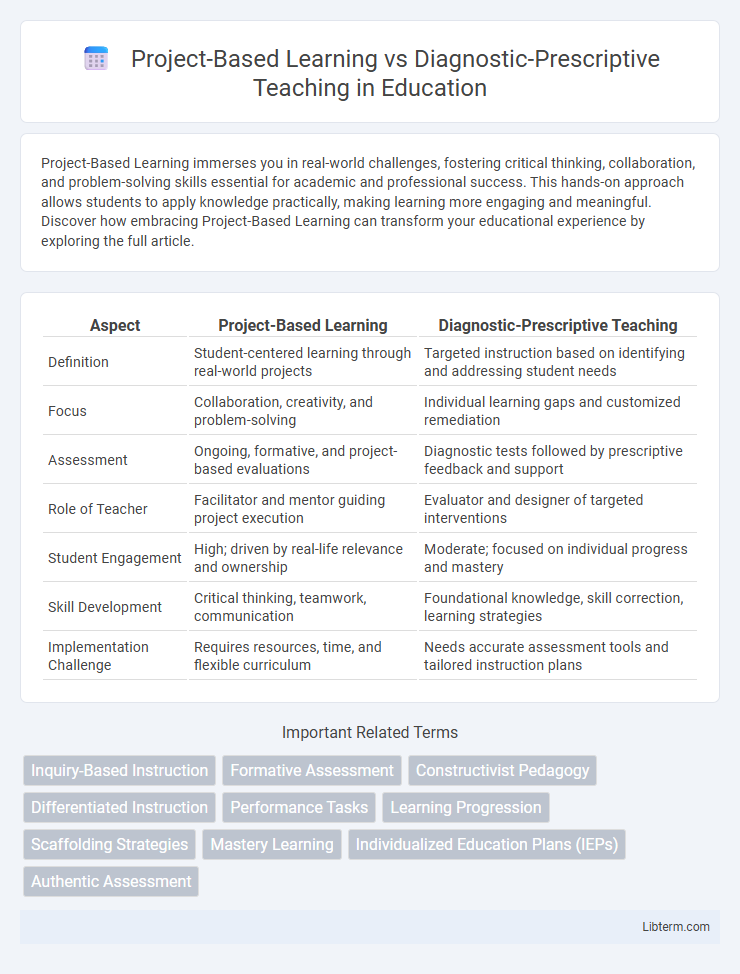Project-Based Learning immerses you in real-world challenges, fostering critical thinking, collaboration, and problem-solving skills essential for academic and professional success. This hands-on approach allows students to apply knowledge practically, making learning more engaging and meaningful. Discover how embracing Project-Based Learning can transform your educational experience by exploring the full article.
Table of Comparison
| Aspect | Project-Based Learning | Diagnostic-Prescriptive Teaching |
|---|---|---|
| Definition | Student-centered learning through real-world projects | Targeted instruction based on identifying and addressing student needs |
| Focus | Collaboration, creativity, and problem-solving | Individual learning gaps and customized remediation |
| Assessment | Ongoing, formative, and project-based evaluations | Diagnostic tests followed by prescriptive feedback and support |
| Role of Teacher | Facilitator and mentor guiding project execution | Evaluator and designer of targeted interventions |
| Student Engagement | High; driven by real-life relevance and ownership | Moderate; focused on individual progress and mastery |
| Skill Development | Critical thinking, teamwork, communication | Foundational knowledge, skill correction, learning strategies |
| Implementation Challenge | Requires resources, time, and flexible curriculum | Needs accurate assessment tools and tailored instruction plans |
Introduction to Project-Based Learning and Diagnostic-Prescriptive Teaching
Project-Based Learning (PBL) emphasizes active student engagement through real-world problem-solving, fostering critical thinking and collaboration skills by having learners complete complex projects over extended periods. Diagnostic-Prescriptive Teaching centers on identifying individual student learning gaps through assessments and tailoring instructive strategies to address specific misunderstandings or deficiencies. Both pedagogical approaches focus on personalized learning, but PBL prioritizes experiential, interdisciplinary knowledge application, while Diagnostic-Prescriptive methods emphasize targeted remediation based on diagnostic evaluations.
Core Principles and Philosophies
Project-Based Learning emphasizes active, student-centered inquiry where learners engage in real-world projects to construct knowledge through collaboration and critical thinking. Diagnostic-Prescriptive Teaching focuses on identifying individual student learning gaps through assessment and tailoring instruction to address specific needs, ensuring mastery of foundational skills. Both approaches prioritize personalized learning but differ fundamentally in methodology--one fosters exploration and application, while the other centers on remediation and targeted skill development.
Key Differences in Instructional Approach
Project-Based Learning emphasizes student-centered, hands-on experiences where learners engage in real-world tasks to develop critical thinking and problem-solving skills. Diagnostic-Prescriptive Teaching relies on assessing individual student needs through diagnostics to tailor specific instructional interventions aimed at addressing gaps and enhancing mastery. The key difference lies in Project-Based Learning fostering exploratory collaboration and creativity, whereas Diagnostic-Prescriptive Teaching prioritizes targeted remediation based on assessment data.
Curriculum Design and Implementation
Project-Based Learning emphasizes curriculum design that integrates real-world problems, fostering critical thinking and collaboration through hands-on activities aligned with specific learning objectives. Diagnostic-Prescriptive Teaching focuses on identifying student learning gaps through assessments and tailoring curriculum content and instructional strategies to address individual needs effectively. Implementation of Project-Based Learning requires flexible timelines and interdisciplinary resources, whereas Diagnostic-Prescriptive approaches depend on continuous evaluation and adaptive lesson planning to ensure mastery of foundational skills.
Roles of Teachers and Learners
In Project-Based Learning, teachers act as facilitators guiding students through real-world problem-solving, while learners take active roles in collaboration and critical thinking. In Diagnostic-Prescriptive Teaching, educators diagnose individual student needs and prescribe tailored interventions, positioning learners as receivers of targeted instruction for skill mastery. Both approaches demand dynamic teacher involvement but differ fundamentally in student autonomy and instructional focus.
Assessment Methods and Outcomes
Project-Based Learning employs formative assessments emphasizing collaboration, creativity, and real-world problem-solving skills, resulting in improved critical thinking and student engagement. Diagnostic-Prescriptive Teaching relies on diagnostic assessments to identify individual learning gaps, followed by targeted interventions to enhance specific academic skills and knowledge retention. Both approaches leverage assessment data to tailor instruction but differ in scope and application, with Project-Based Learning fostering holistic skill development and Diagnostic-Prescriptive Teaching focusing on remediation and mastery of discrete content areas.
Benefits and Challenges of Project-Based Learning
Project-Based Learning (PBL) enhances critical thinking, collaboration, and real-world problem-solving skills by engaging students in complex, hands-on projects that foster deeper conceptual understanding. Challenges of PBL include the need for extensive planning, resource allocation, and the difficulty in assessing individual student performance within group tasks. Despite these obstacles, PBL prepares learners for dynamic work environments by promoting creativity, adaptability, and intrinsic motivation.
Advantages and Limitations of Diagnostic-Prescriptive Teaching
Diagnostic-Prescriptive Teaching offers tailored instruction by identifying students' specific learning difficulties through assessment and delivering targeted remediation, enhancing individualized learning outcomes. Its advantage lies in addressing gaps efficiently and supporting learners who struggle with foundational concepts. However, this method can be time-consuming, may limit creativity by focusing narrowly on deficits, and often relies heavily on teacher expertise for accurate diagnosis and effective intervention.
Real-World Applications and Case Studies
Project-Based Learning (PBL) emphasizes hands-on real-world applications by engaging students in complex, authentic projects that develop critical thinking and problem-solving skills. Diagnostic-Prescriptive Teaching uses case studies and assessments to identify individual learning gaps and tailor instruction for targeted skill remediation. Both methods integrate real-world contexts, but PBL fosters collaborative, active exploration, while Diagnostic-Prescriptive prioritizes personalized, evidence-based intervention strategies.
Choosing the Right Approach for Diverse Learners
Project-Based Learning engages diverse learners by promoting collaboration and real-world problem solving, fostering critical thinking and creativity. Diagnostic-Prescriptive Teaching provides tailored instruction through ongoing assessment, targeting specific learning gaps to optimize individual progress. Selecting the right approach depends on learner needs, with Project-Based Learning suiting experiential learners and Diagnostic-Prescriptive ideal for mastery of foundational skills.
Project-Based Learning Infographic

 libterm.com
libterm.com